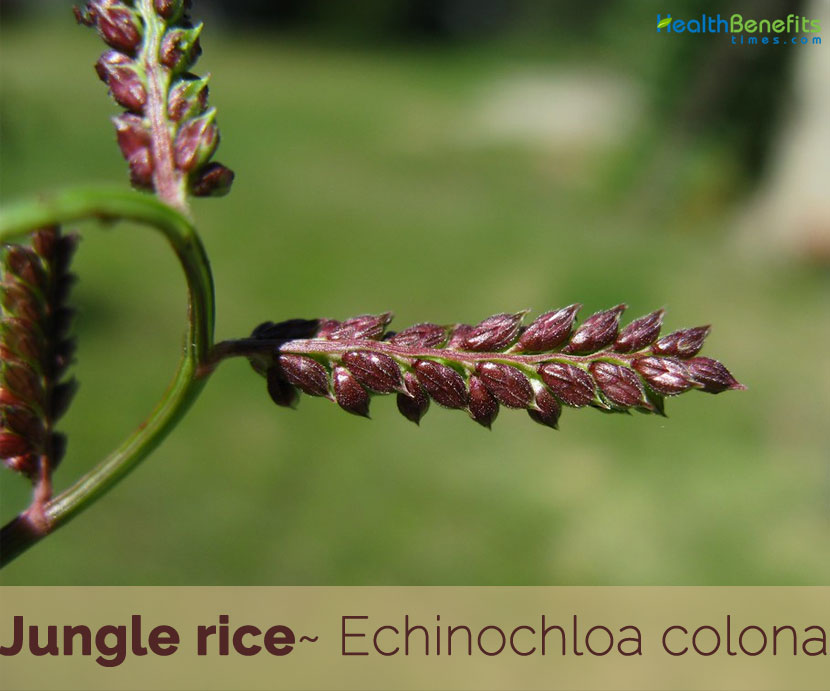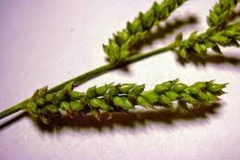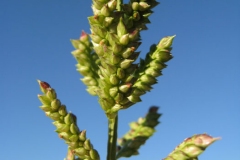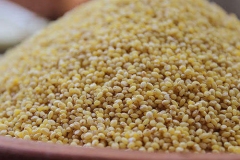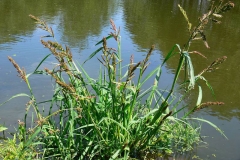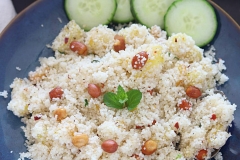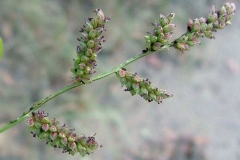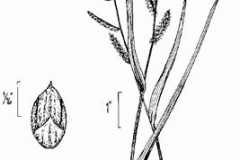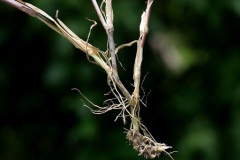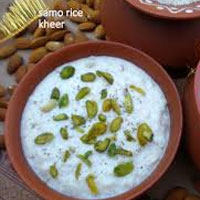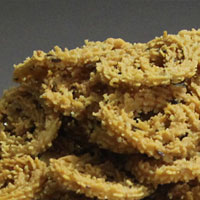| Jungle rice Quick Facts | |
|---|---|
| Name: | Jungle rice |
| Scientific Name: | Echinochloa colona |
| Origin | Tropical Asia – Himalaya to West Malaysia |
| Shapes | Caryopsis about 1.3- 2 mm long |
| Health benefits | Improve heart health, Boost immune system, Maintain healthy digestion, Lose weight, Good for diabetic, Energizing |
| Name | Jungle Rice |
|---|---|
| Scientific Name | Echinochloa colona |
| Native | Tropical Asia – Himalaya to West Malaysia. It is cultivated as a fodder grass and cereal in tropical Asia, Africa, Australia, western United States and Canada and in China- Anhui, Guangxi, Guizhou, Heilongjiang, Henan, Nei Mongol, Ningxia, Sichuan, Yunnan and Taiwan |
| Common Names | Billion-Dollar Grass, Cockspur Grass, Indian Barnyard Millet, Japanese Millet, Japanese Barnyard Millet, Sanwa Millet, Sawa Millet, Shama Millet, Siberian Millet, White Millet, White Panic, White Panicum, awnless barnyard grass, barnyard grass, bird’s rice, corn panic grass, Deccan grass, jungle rice, jungle ricegrass, jungle-rice, junglerice, Kalahari watergrass, marsh grass, millet-rice, pigeon millet, river grass, short millet, swamp grass, swampgrass |
| Name in Other Languages | Afrikaans: Watergras Arabic : Abu rokba, Abu rukbah, Bashaft, Difra, Diffré Argentina: Arroz Silvestre, capím, grama pintado, pasto Colorado Assamese: Binoi-bon Australia: Awnless barnyard grass Bangladesh: Alighasha, khudhey shayma, shymaghas Barbados: Junglerice Bontoc: Tumi Brazil: Capim da colonia, capim-arroz, capim-arroz, capim-colônia, capim-coloninho, capim-jaú, capituva, jervâo Burmese: Myet thi, Pa zun sa myet Catalan: Cerreig, Mill, Panissola, Pota de gall menuda, Serreig roig, Serret Chamorro: Chaguan-agaga Chad: Diffré Chile: Hualcacho Chinese: Guang tou bai ( 光头稗), Guang tou bai zi, Can cao, Wang bai, Wang ji, Hu Nan Bai Zi, Hu Nan Ji Zi Colombia: Liendre de puerco; paja de apto Cuba: Armilán, buche de guanajo, grama pintada, pico de paloma Czech: Ježatka osadní Danish: Spinkel hanespore, Bleg Hanespore, Japanhirse Dominican Republic: Barba de indio, grama, pata de cotorra, pata de guanaj, tito blanco Dutch: Zuidelijke hanepoot, Japanse Gierst, Europese hanenpoot Egypt: Abu rokba English: Jungle ricegrass, Jungle-rice, Millet-rice, Corn panic-grass, Deccan grass, Southern cockspur, Awnless barnyard grass, shama millet, wild millet, bird’s rice, marsh grass, swamp grass, barnyard millet, corn panic grass, jungle rice, little baryard grass, pigeon millet, short millet, swampgrass, Kalahari watergrass, millet rice Estonian: Söödav Kukehirss Fiji: Junglerice Finnish: Kukonhirssi, Japaninhirssi, tipunhirssi French: Blé du Dekkan, Pied de coq méridional, herbe de Greslan, herbe de riz, herbe sifflette, Echinochloé des cultures, Millet Japonais, Pied De Coq Cultivé, oplismène des cultures, panic colonisateur, panic des cultivateurs, panic pied-de-coq German: Dekkangras, Schamahirse, Südliche Hühnerhirse, Kleine Hühnerhirse, Kolonisten-Hühnerhirse, Japanhirse, Japanische Hirse, Schamahirse, Sawahirse, Weizenhirse, Colona-Hühnerhirse Gujarati: Samo (સામો), Moriyo Hebrew: Dochaneet hashaleen, dachenit hashalchin, דָּחְנִית הַשַּׁלְחִין Hindi: Jangli jhangora, Shama (शामा), śyāmāk (श्यामाक ), जंगली चावल (jangalee chaaval), borur, hama, homa, jangli sawak, janguli, jiria, junglerice, karum-pul, kavada, kudiravali, otha gaddi, pacushama, pakud, samo, sanwa, sarwak, sawa, sawank, shama millet, shamak, sharma, soma, swanter, tan, todia, tor, zari Hungarian: Sáma-köles Ilocano: Dakkayang Indonesia: Jajagoan leutik, padi burung, rumput bebek, rumput jajagoan kecil, rumput kusa-kusa, tuton, watoeton Iloko: Dukayang Iraq: Dahnan Israel: Dochaneet hashaleen Italian: Panico porporino, Giavone meridionale, Miglio Giapponese Jamaica: Junglerice Japanese: Ko hime bie (コヒメビ エ), Wase bie (ワセビエ), indobie, Hie Javanese: Suket tuton Kannada: Kaadu haaraka, Kaadu haaraka hull Laotian: Khauz nôk, nya khao nôk Lebanon: Junglerice Malay: Padi burong, Padi burong, Rumput kekusa , Rumput kusa-kusa, Rumput bébék, Rumput kekuasa kecil, Tuton, Watuton Malaysia: Junglerice, padi burung, rumput kekusa, rumput kekusa kecil, rumput kusa-kusa, tuton Malayalam: Kavada Marathi: Borur, Jiria, Pacushama, Sawank, śyāmāka (श्यामाक ) Mauritius: Herbe de riz, herbe sifflette Mexico: Arrocillo, arroz del monte, zacate pinto Myanmar: Myet-thi, pazun-sa-myet, wan-be-sa-myet Nepali: Saamaa (सामा), Saamaa ghans Netherlands: Zuidelijke hanepoot Nicaragua: Pato de conejo Palauan: Uaum Peru: Champa Philippines: Bulang, dakayang, dakayon, dukayang, dukdukayang, guinga, gutad, la-u la-u, mangagaw, pulang-puwit, pulang-pwet, tiriguhan, tumi Portuguese: Capim-arroz, Capim da colonia, Capim-colônia, Capim-coloninho, Capim-jaú, Jervâo, capituva, milhã-listrada, milhã-pé-de-galo, angolinho-branco, inco-do-arroz Puerto Rico: Arrocillo, arroz de monte, grama pintada Punjabi: Samāka (ਸਮਾਕ ), Samāki (ਸਮਾਕੀ), Savāk, Savāṅka (ਸਵਾਂਕ) Savãk, Sānvaka (ਸਾਂਵਕ) Sãvak , Suãnka (ਸੁਆਂਕ), Sā’uṅka (ਸਾਉਂਕ) Sa’uṅka (ਸਉਂਕ) Russian: Kurinoe proso (Куриное просо), Ežovnik Chlebnyj, yezhovnik krest’yanskiy (ежовник крестьянский), yezhovnik piramidal’nyy (ежовник пирамидальный) Palauan: Uaum Samoan: Sefa South Africa: Junglerice, watergras Spanish: Arrocillo, Grama pintado, Hualcacho, Liendre de puerco, Paja de apto, Pata de gallina, Pasto colorado, Pasto del arroz, Pierna de gallo meridonal, armilán, camalote, champa, grama de verano, pata de conejo, zacate de agua, zacate pinto, zancaraña, Mijo Japonés, capim arroz, paja de arroz, pata de gallo, grama pintada, gramilla de rastrojo, pasto overito, mata bravo Sri Lanka: Adipul, gira-tana Sudan: Difra, junglerice Sundanese: Jajagoan leutik Swedish: Kycklinghirs, Amerikansk Hönshirs, Blek Hönshirs Tagalog: Pulang puwit Tamil: Cāmai (சாமை), Pullam payiṟu (புல்லம் பயிறு) Telegu: Cāma (చామ), Othagaddi Thai: H̄ỵ̂ā pl̂xng (หญ้าปล้อง) Yaa bplong, H̄ỵ̂ā nkk̄heā (หญ้านกเขา) Yaa nok khao, Ya nok sichom phu, ya plong; yaa khaao nok; yaa nok si chomphu, H̄ỵ̂ā k̄ĥāwnk (หญ้าข้าวนก) Tongan: Matala‘ulie, muhuku‘apopoa Trinidad and Tobago: Junglerice Turkish: Tavshéan out, cinek Uruguay: Capim, gramilla de rastrojo USA: Junglerice Vietnamese: Co long vuc, Cỏ Kê, Cỏ Núc, Cỏ Lồng Vực Hạt Visayan: Guinga Welsh: Cibogwellty trofannau Zambia: Lupungu, zibaila |
| Plant Growth Habit | Clump-forming, annual (rarely perennial) grass |
| Growing Climates | Swampy places, near marshes, around water pipes, rice fields, roadsides, river banks, shores of ponds, the inner edges of mangrove swamps, old clearings, waste places, cultivated fields, ditches, gardens, disturbed sites, waterways, waste grounds, flooded grasslands, edges of saline waterholes, irrigated fields |
| Soil | Predominant on damp, fertile, heavy-textured soils in areas which are seasonally rather than permanently flooded. It is often cultivated on marginal lands where rice and other crops will not grow well |
| Plant Size | 1–1.2 m |
| Root | Fibrous root |
| Culms | Glabrous, cylindrical, erect and decumbent. They are red purple at their base and can root at the lower nodes |
| Stem | Stem is flattened, often red purple at the base, usually swollen at the nodes |
| Leaf | Leaf sheath is smooth, margins free in upper part and basal portion of sheath is often tinged with red. Leaf blade is smooth, flat, linear lanceolate, flaccid, up to 25 cm long, 3 7 mm wide, sometimes transverse purple bands. |
| Flowering season | July to September |
| Flower | Inflorescence is green to purple, 6-12 cm long and bears 4-8 short racemes on the main axis. The sessile awnless spikelets are arranged in 4 rows on one side of the racemes |
| Fruit Shape & Size | Caryopsis about 1.3- 2 mm long |
| Propagation | By Seed |
| Season | August to October |
| Health Benefits |
|
Plant Description
Jungle rice is a clump-forming, annual (rarely perennial) grass that normally grows about 1–1.2 m tall. The plant is found growing in swampy places, near marshes, around water pipes, rice fields, roadsides, river banks, shores of ponds, the inner edges of mangrove swamps, old clearings, waste places, cultivated fields, ditches, gardens, disturbed sites, waterways, waste grounds, flooded grasslands, edges of saline waterholes and irrigated fields. The plant is predominant on damp, fertile, heavy-textured soils in areas which are seasonally rather than permanently flooded. It is often cultivated on marginal lands where rice and other crops will not grow well. The plant has shallow fibrous root. Culms are stout, usually reddish-purple, erect, ascending or decumbent, often branching from the base, often rooting at the lower nodes, 20-60 cm tall, sometimes nodes conspicuously swollen and usually geniculate, compressed, lower inter nodes often exposed.
Leaves
Leaf sheaths are smooth and glabrous and leaf is linear, soft, 15–40 cm long and 1–2.5 cm wide, glabrous, with wavy margins and without ligules. Panicles is 15–20 cm long, erect to slightly drooping at maturity.
Inflorescence
Inflorescence is a terminal panicle with widely spaced, appressed or spreading branches of spike-like racemes, branches single or occasionally paired at the nodes. These primary branches unbranched, panicle mostly 0.03-0.15 m long, branches 0.01-0.02 (hardly 0.03 m) long; axis and branches glabrousor with some hairs. Spikelets are sub sessile, paired, and densely arranged from branch base along one side of the flattened rach is in 2-4 rows.
Spikelets
Spikelets have one terminal perfect floret with a sterile floret below, with two glumes. Spikelets are 0.00254 m long and 0.001-0.0015 m wide, ovate to elliptic, awnless but sharp-pointed, weakly hispid-scabrous on the veins; sub sessile; disarticulating below the glumes. First glume is acute, thick, triangular, 0.001-0.0015 m long, about half as long as spikelet, 3-5 veined; second glume and sterile lemma equal, acute to acuminate, usually hispid-scabrous to glabrate, faintly veined, veins weakly hispid-scabrous; sterile lemma 5-veined. Fertile lemma is plano convex, elliptic, smooth and shiny, abruptly sharp-pointed or cuspidate, margins in rolled below over palea with the apex of palea not enclosed. Palea is flat, surface texture similar to fertile lemma. Caryopsis is 0.0018 m long, elliptic and acute.
History
Its native habitat is unknown and is believed to be in Asia – Himalaya to West Malaysia. It is considered to be a cultivated derivative of Echinochloa colona that arose in India and perhaps Africa. It is cultivated as a fodder grass and cereal in tropical Asia, Africa, Australia, western United States and Canada and in China- Anhui, Guangxi, Guizhou, Heilongjiang, Henan, Nei Mongol, Ningxia, Sichuan, Yunnan and Taiwan.
Health Benefits of Jungle Rice
As mentioned above, we can have the health benefits of jungle rice by regularly consume this tiny grained rice. Just like the common Benefits of Seeds and Grains for overall health, here are some health benefits we can get from consuming jungle rice.
1. Improve heart health
Dietary fiber in jungle rice is also good to improve the health of the heart. It is possible since the healthy food with high fiber content is able to cut off the bad cholesterol in the blood. As we know, cholesterol is strongly linked with the health of heart. This way, the consumption of jungle rice is able to reduce the risk of heart diseases, such as coronary heart.
2. Boost immune system
Samo or jungle rice consists of a good amount of vitamin C. the existence of vitamin A, C, and fiber as the antioxidants in jungle rice is able to prevent many diseases development. The antioxidants are able to combat the attack from free radicals and help eliminating unwanted material in the body.
3. Maintain healthy digestion
Not only the excellent in controlling weight, the dietary fiber in jungle rice is beneficial for the whole digestive system. This digestible food is able to maintain bowel movement, so that it is potential to prevent constipation. In addition, the minerals such selenium and manganese is able to protect the gastro intestinal lining by form a shield, so that it is not easily infected.
4. Good for diabetic
Although jungle rice consists of good amount of carbohydrate, it is proved to be low in sugar content. It makes jungle rice or samo is very good for people with diabetes. It is possible since diabetic should consume foods with low glycemic index. This way, diabetic is able to avoid spike up blood sugar by replacing white rice with jungle rice. In addition, they don’t have to worry about the taste, as the jungle rice is able to be combined with their usual favorite side dishes for rice and the most important thing, it is equally filling.
5. Lose weight
High level of dietary fiber in jungle rice enables you to feel full a little longer after eat this rice. This way, you can prevent cravings and manage your food intake. It is very suitable for you who are in weight loss diet program. Jungle rice will do amazing thing to your weight.
6. Energizing
We can consider jungle rice as one of the healthy and beneficial staple foods for some reasons. One of the reasons is that it has balanced carbohydrate, protein, and fat. It is just as suggested by the healthy Ayurveda food. The perfect composition of carbohydrate, protein, and fats as the main sources of energy is able to provide us with energy.
In spite of the energy content in jungle rice, it yet still feels light in the digestive tract. The benefits can also be obtained from regular rice with a super food Quinoa, which own the Health Benefits of Rice and Quinoa.
Traditional uses and benefits of Jungle Rice
- The plant is useful in the treatment of biliousness and constipation.
- The plant is used in spleen and hemorrhage problems.
- It is also used in nausea and constipation.
- Tuber of the plant is said to be possess anti-emetic values and act as a sedative in dyspeptic disorders particularly in vomiting during pregnancy.
- Entire plant or parts of the plant are used for different disorders including wound healing, anti-diabetic, anti-ulcer and antiseptic.
Culinary Uses
- Seeds are cooked and used as millet.
- Seed can be cooked whole or ground into flour and used as a mush or porridge.
- Young plants and shoots are consumed raw or cooked.
- It can be consumed raw with rice.
- Young shoots of barnyard millets are eaten as a vegetable in Java.
- Seeds are boiled in water and used as a substitute for rice in Rajasthan, India.
- Seeds are also ground into flour, sometimes being mixed with maize or black gram, and made into bread or porridge.
- In India seeds of this grass are used to prepare a food dish called khichadi and are consumed during festival fasting days.
- The grain can be cooked whole in water, like rice, or boiled with milk and sugar and eaten as porridge or can be ground into flour.
- Grains can be fermented to make beer.
- Young plants and shoots are edible and can be eaten in times of scarcity.
Jungle rice pudding for fast
Ingredients
- Jungle rice ¼ cups
- Ghee 1 tsp
- Milk 3 cups
- Sugar 3-4 tbsp.
- Pistachio 1 tbsp.
- Almonds 3 tbsp.
- Green cardamom 4
Directions
- Clean and wash the Jungle rice. Soak them in the water for 5 minutes. Remove the water and leave the Jungle rice on the strainer.
- Blance, and thinly slice the pistachio, and almonds.
- Remove the green skin of the cardamoms and grind the seeds in the mortar.
- In a sauce pan/wok heat the ghee. Now fry rice for a minute in the ghee on medium heat.
- Add milk in the rice and boil it on medium heat. After the first boil reduce the heat and cook until rice is completely cooked. It takes about 10 minutes to cook the rice. Keep stirring the mixture.
- Add sliced almonds, and sugar. Mix well and cook for a couple of minutes. Turn off the heat.
- Jungle rice kheer is ready. Let it cool.
- Garnish with ground cardamoms and slivered pistachio and serve.
Jungle rice Chakli
Ingredients
- Jungle rice – 125 grams (3/4 cup)
- Cumin seeds – 1/2 tsp.
- Rock salt – 1/2 tsp. or as per taste
- Sesame seeds – 1 tsp.
- Peppercorns – 1/2 tsp. (freshly ground)
- Oil – 1 tbsp.
- Oil – for frying chakli
Directions
- Wash the Jungle rice and soak them in water for 2 hours. After this drain the water and grind them bit coarsely in a mixture grinder without adding water. If required, add 1 or 2 tsp. water.
- Place the pan over flame; add rice paste and 1 tsp. oil to it. Roast for 1 to 2 minute on medium flame. Stir constantly to roast the paste. Thicken the paste until it gets consistency same as that of dough.
- Take out dough in a bowl and allow it to cool. Now add cumin seeds, sesame seeds, rock salt, peppercorns and knead the dough until smooth and soft. Dough for making chakli is ready.
Making Chakli
- Make a lump from dough and roll lengthwise. Now place this dough ball into the chakli machine (cookie press). Close the machine.
- Take a thick polythene sheet and place it over kitchen top.
- Press the machine and make round chaklis over the polythene sheet. Make 7 to 8 chaklis over the polythene sheet.
Frying Chaklis
- Take oil in a wok and heat. The oil should be medium hot. Lift up the chakli from polythene sheet very gently so that its shape remains intact.
- Place the chakli in hot oil. Fry the chaklis on medium-high flame. Place as many chaklis as possible in the oil and fry until they turn golden brown in color from all sides.
- Take them out in plate with absorbent paper. Likewise prepare all chaklis.
- Chakli for fasts is ready. When chakli cools, place them in air tight container and relish eating whenever you want for up to a month.
Other facts
- The seed of Jungle rice is used as a feed for caged birds.
- This millet is cultivated for forage and grain, also sometimes as a soil stabilizer.
- It is frequently planted for temporary control of erosion in newly cleared and ploughed sandy soils because they grow rapidly and seed is cheap.
- Jungle rice is a valuable fodder relished by all classes of livestock, notably dairy animals and water buffaloes.
- Stems are used in weaving mats.
References:
https://www.itis.gov/servlet/SingleRpt/SingleRpt?search_topic=TSN&search_value=40670#null
http://www.hear.org/pier/species/echinochloa_colona.htm
https://npgsweb.ars-grin.gov/gringlobal/taxonomydetail.aspx?id=316659
https://pfaf.org/user/Plant.aspx?LatinName=Echinochloa+colona
https://www.cabi.org/isc/datasheet/20368
http://www.floracatalana.net/echinochloa-colona-l-link
https://plants.usda.gov/core/profile?symbol=ECCO2
https://en.wikipedia.org/wiki/Echinochloa_colona
https://www.feedipedia.org/node/452
http://www.theplantlist.org/tpl1.1/record/kew-410176
https://keyserver.lucidcentral.org/weeds/data/media/Html/echinochloa_colona.htm
http://www.knowledgebank.irri.org/training/fact-sheets/item/echinochloa-colona
https://uses.plantnet-project.org/en/Echinochloa_colona_(PROSEA)
https://gd.eppo.int/taxon/ECHCO
http://tropical.theferns.info/viewtropical.php?id=Echinochloa+colona
https://www.flowersofindia.net/catalog/slides/Jungle%20Rice.html
https://indiabiodiversity.org/species/show/229599


